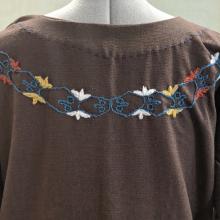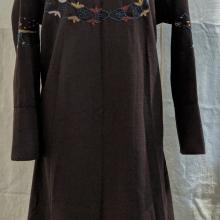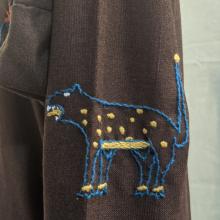What is commonly known as the Mammen embroidery was part a larger archeological find discovered in a mound at Bjerringhod, Denmark in 1868. This find was called “the Mammen Grave”. Usually referred to the Mammen Grave or the Grave at Mammen, the grave’s body called “the Mammen body” was buried between 970- 971 AD (National Museum of Demark). The precision on the dating in the Mammen find is due to the pieces of wood present in the grave (National Museum of Denmark).
In the context of history, the Mammen Grave find is considered one of the first finds of “true embroidery” (Viking Embroidery). Scandinavian finds containing patterned textiles predating Mammen would mostly be considered decorative textile weaving instead of embroidery. As said by Gertrud Grenander-Nyberg, “The tjald (hanging) and refil (a figured frieze like the Bayeux Tapestry) of the Viking Age were composed not of embroidery but of wool-on-linen tapestry weaves” (Grenander-Nyberg, 122). An exception that seems to have been practiced even before the Viking Age was the ornamentation of seams, an example of which is a seam from a seventh-century pillow cover from the Sutton Hoo textiles (Crowfoot, 422).
When the Mammen Grave was excavated, the richly embroidered garments were found in a wooden chamber which was then buried under a mound of earth. This burial style is known as a chamber grave and was a burial method often used for wealthy members of Norse society (National Museum of Denmark). In addition to clothing which was richly adorned with silk and elaborate woolen embroidery; the Mammen body was buried with two axes, a bronze bucket, two wooden buckets, as well as a candle. Based on religious icons in the grave it is unclear whether the deceased was Christian or pagan (National Museum of Denmark).
The National Museum of Denmark commissioned a recreation of the Mammen Grave embroidery, which is now known as “The King Canute” costume. This recreation is based on surviving fragments of the garments and the location of those fragments in relation to the body. Chemical analysis completed by the archeologists indicate that dark blue, white, orange, gold, and red-brown thread would have been used for the embroidery and that the fabric of the tunic was originally red (See fig 2 for color placement) (Worsaae). The drawings of the motifs used on the tunic are shown in figures 1, 2, and What is commonly known as the Mammen embroidery was part a larger archeological find discovered in a mound at Bjerringhod, Denmark in 1868. This find was called “the Mammen Grave”. Usually referred to the Mammen Grave or the Grave at Mammen, the grave’s body called “the Mammen body” was buried between 970- 971 AD (National Museum of Demark). The precision on the dating in the Mammen find is due to the pieces of wood present in the grave (National Museum of Denmark).
In the context of history, the Mammen Grave find is considered one of the first finds of “true embroidery” (Viking Embroidery). Scandinavian finds containing patterned textiles predating Mammen would mostly be considered decorative textile weaving instead of embroidery. As said by Gertrud Grenander-Nyberg, “The tjald (hanging) and refil (a figured frieze like the Bayeux Tapestry) of the Viking Age were composed not of embroidery but of wool-on-linen tapestry weaves” (Grenander-Nyberg, 122). An exception that seems to have been practiced even before the Viking Age was the ornamentation of seams, an example of which is a seam from a seventh-century pillow cover from the Sutton Hoo textiles (Crowfoot, 422).
When the Mammen Grave was excavated, the richly embroidered garments were found in a wooden chamber which was then buried under a mound of earth. This burial style is known as a chamber grave and was a burial method often used for wealthy members of Norse society (National Museum of Denmark). In addition to clothing which was richly adorned with silk and elaborate woolen embroidery; the Mammen body was buried with two axes, a bronze bucket, two wooden buckets, as well as a candle. Based on religious icons in the grave it is unclear whether the deceased was Christian or pagan (National Museum of Denmark).
Figure 1: Image of some of the surviving extant tunic (Hald and Worsaae)
The National Museum of Denmark commissioned a recreation of the Mammen Grave embroidery, which is now known as “The King Canute” costume. This recreation is based on surviving fragments of the garments and the location of those fragments in relation to the body. Chemical analysis completed by the archeologists indicate that dark blue, white, orange, gold, and red-brown thread would have been used for the embroidery and that the fabric of the tunic was originally red.
Based on our current archeological evidence, tailoring and some needlework can be traced to Stone Age Scandinavia (Bender Jørgensen, 116) Textile weaving techniques were not adopted until the Bronze Age. Embroidery in the form of thread being stitched over fabric began in Scandinavia around the 9th century (Bender Jørgensen, 116).
Embroidery came late to Scandinavia, during the early Viking Age and its progress and advancement once it reached Scandinavia was slow, however textile weaving techniques were far more prevalent. There are two types of these decorative designs, tjald (hangings) and refil (figured freeze like the Bayeux Tapestry) (Grenander-Nyberg, 122). Examples of textile weaving techniques include the Bayeux Tapestry as well as clothing finds from excavated graves.
As the Viking Age progressed, Norse art took diverse and elaborate forms due to the extent of Norse trade routes. Embroidery in the form of decorative stitches applied to already woven fabric appeared in the early 9th century (Priest-Dorman), when influences from the many cultures that the Norse interacted with began to influence art and technology. The two most distinct areas of influence came from the West represented by finds at Bjerringhøj and Jorvík and a style influenced by the lands to the east represented by finds at Birka and Valsgärde. (Priest-Dorman) Around the world, intact finds showing embroidery are rare.
The Western style was influenced by the Anglo-Normans. Largely fiber on fiber, these stitches are still used in modern times and include: chain stitch, couching stitch, and raised herringbone stitch. (Priest-Dorman). Many existing examples of the Western style are shown in embroidered works that have Christian influence. Silk used in this context would have been imported from the east and would also have been extremely expensive. Wool and linen would have been the most common embroidery materials for this region’s embroidery. This style of embroidery was used to reinforce garments, especially on the seams in addition to being decorative (Ingstad, 92)(Crowfoot, 422).
The Eastern style was influenced by Kievian, Rus, Byzantine, and Slavic cultures. This style relied heavily on wire and thread over cloth as decoration. This style was more focused on surface decoration than reinforcement of cloth. Motifs of animals and vegetation are very common in this style. Some finds also show ornaments involving masks (Ingstad, 96).
Overall, the Norse used embroidery for both decoration and reinforcement of cloth. Use of color and the level of detail of embroidery could be used to show social status. Embroidery is a time-consuming task so those who could afford elaborate both the embroidery and materials used in its creation were likely wealthy. Many stitches were also used to reinforce clothing along the seams (Crowfoot, 422). This embroidery style would likely have been used by many social classes as it increased the longevity of garments. As a result, much of Norse ornamentation is highly functional as well as beautiful.
The Mammen Grave embroidery was worked largely in stem stitch (Iversen). Functionally, stem stitch serves diverse purposes, it can be used as a reinforcement stitch for seams and as a filling or outlining decorative stitch. Probably the best-known large-scale uses of stem stitch can be seen in the Bayeux Tapestry and the Mammen Grave. This stitch has been found in five grave sites in Birka (Sweden) dating from the 10th century (Geijer, 108f). These findings show the use of the stitch on men and women’s clothing as a stitch used to reinforce seams (Geijer, 109). As well as use of thread on seams as a decoration (Geijer, 170) Used as a filling stitch in the Birka finds, stem stitch was primarily used to reinforce seams and on the edges of applique (Hägg 1984, 169). The find at the Mammen Grave site showcases more use of stem stitch, both as an outlining and fill stitch. This find does not give a good idea of where embroidery would have typically been placed on Norse clothing (Jones 2002).
Motifs found on the clothing of the Mammen Grave are diverse. Depictions cross all the garment pieces in the grave include: Acanthus vine, small faces, leopards, large faces and hands, trees with paired beasts, and birds. The large faces with hands on the cloak/burial shroud are of Norse origin. The smaller faces around the neckline of the tunic are more similar to images seen on caskets found at Bamberg and Cammen. The leopard hindquarters are also a Norse design. Both the smaller faces and leopard embroidery (shown below) were found on the tunic fragments (Jones 2002).
For this project, use of stem stitch, wool thread, and wool base fabric are all true to the extant piece. The colors I have used are based on a chemical analysis of the remaining dye by the archeologists (National Museum of Denmark). True thread colors of the extant tunic are too degraded to decidedly determine the original hue by visual analysis. As my focus in this piece was to recreate the embroidery as accurately as I could, I did not attempt a period tunic pattern. That will be a challenge for a later project.
To start the tunic, I cut out the base shape and completed the neckline. The side seams were left open to give better access to the areas being embroidered. I completed the seam treatments on the collar and sleeves first, both in running stitch, then began the decorative embroidery. The first pieces of embroidery I completed were the leopards on the upper sleeves of the tunic, and finally the faces running across the chest and back of the tunic. Finally, I closed the sides and completed a running stitch seam treatment to finish the seams and the tunic as a whole.
One liberty that I did take was only working the faces on the chest and upper back of the tunic. It was unclear on the remaining extant pieces whether or not the faces dipped down the back as far as they do on the front. I chose to connect the faces across the back just below the collar. I made this choice because the design of the faces lends itself to an unbroken chain, thus it would not have stopped when it reached the top of the wearer’s shoulders.
Lessons Learned
This project was a foray into a new side of embroidery for me. New things that I tried were: using wool thread, using wool as a base fabric, recreating a period piece based on existing research, and sewing motifs that are so repetitive. I found it difficult keeping the faces on the front and back of the tunic even. It was also tempting to make the stitches longer than they should be when working around the curves on the face’s chins and noses. This was a temptation that required redoing sections of the faces to correct the error.
While I have worked extensively with stem stitch before, all previous works were completed with fine cotton pearl thread. A few differences that I noticed between working with wool and cotton threads were that wool thread has a less even thickness, a looser and therefore more fragile weave, and the wool thread was more prone to slipping out of my needle. To adjust for these differences, I had to shorten the individual lengths of thread that I put onto my needle at a time.
Another lesson learned is verifying that the base fabric is pure wool. While I did conduct a burn test on my base wool before beginning this tunic, I discovered part way through the first leopard that there was more stretch to the wool than there should have been. As the burn test was clean, I assume that an unknown natural fiber was added to this wool. The extra stretch made the fabric more prone to puckering despite the embroidery hoop holding it taunt.
After completing this project, the use of seam treatments makes more sense to me. Hand spun thread used in period would have been more prone to pulling apart than machine spun modern thread. Seam treatments would have helped reduce the tension on any one strand of thread, thus reducing the frequency with which seams would need to be mended.
Going forward from this tunic, I would like to experiment more with using stem stitch as a filling stitch rather than an outline. I would also like to complete embroidery in wool thread on a pure wool base and see how that combination interacts.
Ultimately, I feel more confident attempting recreations of extant embroidery finds since completing this tunic. My stitch consistency benefited greatly from the hours of practice, which is already improving the look of embroidery projects I have completed since.
Bender Jørgensen, Lise. 1992. North European Textiles before 1000 A.D. Aarhus, Denmark: Aarhus University Press.
Grenander-Nyberg, Gertrud. 1992. "Soumak Technique in Swedish Medieval Textiles." Archaeological Textiles in Northern Europe: Report from the 4th NESAT Symposium 1.-5. May 1990 in Copenhagen, ed. Lise Bender Jørgensen and Elisabeth Munksgaard, pp. 117-127. Tidens Tand 5. Copenhagen: Det Konglige Danske Kunstakademi.
Geijer, Agnes. 1938. Die Textilfunde aus den Gräbern. Birka: Undersuchungen und Studien III. Uppsala: Kungl. Vitterhets Historie och Antikvitets Akadamien
Embroidery from the 10th Century Grave at Mammen http://www.heatherrosejones.com/mammen/index.html
Hald, Margrethe. 1980. Ancient Danish Textiles from Bogs and Burials. National Museum of Denmark, Copenhagen. ISBN 87-480-0312-3
Iversen, Mette et al. 1991. Mammen: Grav, kunst og samfund i vikingetid. Jysk Arkaeologisk Selskab, Hojbjerg. ISBN 87-7288-571-8
National Museum of Denmark https://en.natmus.dk/historical-knowledge/denmark/prehistoric-period-until-1050-ad/the-viking-age/the-grave-from-mammen/the-costume/?fbclid=IwAR0kl45otmhaCSuNOqiIfj6byZhWc0PXLDWHOBLsFti0Eti1JlQcDMFtARM
Priest-Dorman, Carolyn “Viking Embroidery Stitches and Motifs”1993, 1994, 1997. https://www.cs.vassar.edu/~capriest/vikembroid.html?fbclid=IwAR336uUinYA_ILTggyAAATj5mHvurp7pdb9qXRIFcZk6v7Y5cbf6ghJBAec
Worsaae, I.I.A.. 1869. "Om Mammen-Fundet" in Aarboger for Nordisk Oldkyndighed og Historie. 1869:203-218.
Sources of Figures:
Figure 1 Source: Hald or Worsaae, (both sources contain this image)
Figure 2 Source: National Museum of Denmark
Figure 3 source: Jones 2002
Figure 4 Source: Jones 2002
Figure 5 Source: Stock Image from Google, depicting Stem stitch.




